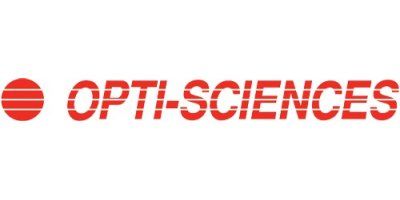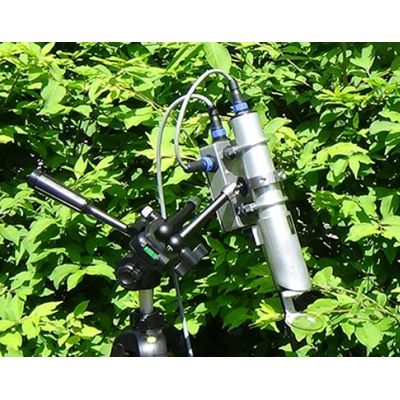

- Home
- Companies
- Opti Sciences Inc
- Products
- Opti-Sciences - Model PSP32 - Plant ...

Opti-Sciences - Model PSP32 - Plant Stress Probe
The monitor chlorophyll fluorometer system is designed to dramatically increase the capabilities of plant monitor systems while also providing more affordable solutions for measuring larger plant populations. The revolutionary daylight dark adaptation capability allows measurement of photoprotective mechanisms, state transitions, chloroplast migration, and photoinhibition at different times of day.
- From 1 to 32 measuring heads are available for each controller, allowing the longer term measurement of larger plant populations and more affordable configurations.
- Daylight dark adapting measurement of fast reacting qE or energy-dependent exciton quenching; qM or chloroplast migration; qT or state transitions; and qI or photoinhibition, at different times of day, and over long periods of time.
- Measures plant photoprotective mechanisms with pNPQ and qPd from the Ruban / Murchie protocol (2012)
- 10,000 μmol square topped saturation flash or FM` correction option according to Loriaux 2013 for more reliable light adapted results.
- Different versions are available for a range of applications. Heads can be purchased with either blue modulated, actinic, and saturating light, or red modulated, actinic, and saturating light.
- Different measuring heads can be combined in the same system. Some can use red light, some blue light and some can be provided with daylight dark adaptation accessories.
- Option for far-red light to measure FO`, and Kramer`s fast quenching parameters: NPQ(T), qE(T), & qI(T)
- Stores up to 1 Gb of data or at least one year`s worth of data.
- Solar power, 12 volt battery power or mains power
- Communications: Cellular, WiFi, USB
The Monitor chlorophyll fluorometer - is designed to be the next generation system. It`s structure allows from 1 measuring head to 32 measuring heads to be attached to a single instrument controller. This allows larger populations of plants to be measured for a more affordable price. It also allows expansion of an existing system to fit other needs, or allows expansion as funding becomes available. The monitor system allows field, green house or growth chamber measurement during the day and during the night, without interruption, for months or years at a time.
A revolutionary improvement, daytime dark adaptation, allows measurement of photoprotection mechanisms (qE, pNPQ and qPd), intense light avoidance (qM or chloroplast migration), low light survival mechanisms (qT or state transitions) and photoinhibition (qI).
Furthermore, more reliable measurements are possible with the addition of leaf temperature measurement, far red light (for FO`), a more intense 10,000 μmol m2/s light adapted saturation flash and an FM` correction option according to Loriaux 2013.
There is also a red light measuring head version available and it may be combined with blue light measuring heads while using the same controller.
Light adapted
Y(II):
Quantum Yield of PSII (or ΔF/FM` or Y(II)).
ETR:
Electron transport rate.
PAR:
Photosynthetically Active Radiation value.
T:
Leaf temperature.
FMS (or FM`):
Maximal fluorescence with actinic illumination using a saturation. pulse
F:
Fluorescence under actinic light (prior to saturation pulse).
Loriaux 2013 correction of ETR, and FM` correction option included for Y(II).
Dark adapted
FV/FM:
Maximum Photochemical efficiency of PSII.
FV/FO:
A more sensitive detector of stress than FV/FM, but it does not measure plant efficiency.
FO:
Minimum fluorescence.
FM:
Maximal fluorescence.
FV:
Variable fluorescence.
FO`:
Minimum fluorescence after exposure to far red light- available with the dark adaptation module.
FO` Estimated without the daylight dark adaptation module.
With Red light measuring head only - Kramer (2016) fast quenching parameters NPQ(T), qE(T) & qI(T).
Quenching
Hendrickson Quenching with NPQ (standard)
Y(NPQ), Y(NO), Y(II), NPQ, FV/FM.
Kramer Quenching (standard)
qL, Y(NPQ), Y(NO), Y(II), FV/FM.
Puddle model parameters (standard)
NPQ, qN , qP , Y(II), FV/FM.
Requires the dark adaptation module option.
Quenching relaxation protocol (option)
qE , qM , qT , qZ, & qI. Ruban / Murchie protocol pNPQ & qPd.
Rapid Light Curves (option)
rETRMAX:
(Eilers and Peeters) a measure of a leaf`s photosynthetic capacity or maximum electron transport rate.
α is the initial slope of line at low PAR values created by relating ETR to PAR. It provides a measure of quantum efficiency.
Ik is the measurement of the actinic light intensity where light saturation dominates, or the minimum saturation level.
Im is the Eilers & Peeters calculated optimal actinic light intensity related to ETRMAX.
Light Sources
Saturation pulse
Blue LED with:
7,000 μmols m2/s with FM` correction option.
10,000 μmols m2/s with square topped flash.
Option for Red LED saturation flash.
7,000 μmols m2/s with FM` correction option.
10,000 μmols m2/s with square topped flash.
Modulated light
Blue 455nm - half band width 18nm
Option for red LED 640nm, half bandwidth 18nm.
Actinic light source:
Blue - Up to 5,000 μmols.
When the optional red light is used, the actinic light intensity can be up to 5,000 μmols.
Far-red light source:
an option included with the day-light dark adaptation option. It is used to measure FO`, or for pre-illumination of samples in the dark adapted mode.
Misc
Detection method:
Pulse modulation method.
Detector & Filters:
A PIN photodiode with a 700nm - 750nm bandpass filter.
Sampling Rate:
Auto-switching from 1 to 10,000 points per sec., depending on test & phase of test.
FM` correction according to Loriaux 2013, for all light adapted modes . It may be turned on or off. Used during daylight hours.
Test Duration:
Designed to measure samples 24 hours per day, 7 days a week, for months at a time. Runs on solar power, battery power, or mains current.
Storage Capacity:
More than 500,000 data sets.
Special Algorithms:
8 point rolling 25 ms average to determine FM, FM`, FO, & FS eliminates saturation pulse NPQ & any electronic noise as an issue.
Output:
Comma delimited files may be opened in Excel. Data maybe retrieved by WiFi, cell phone, SD data card, Radio point-to-point, Ethernet, satellite phone, or USB stick. Some methods are optional.
User Interface:
Display: Graphic color LCD with touch screen interface.
Menu driven.
Power Supply:
Universal Voltage mains power supply included.
May be powered by various types of external 12 volt batteries.
Optional solar power.
Operating temperature:
-10oC to 50oC
Specifications subject to change without notice.
